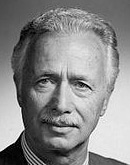

Pietro Belluschi
*18. 8. 1899 – Ancona, Italy
†14. 2. 1994 – Portland, USA
Biography:
Pietro Belluschi was born in Ancona, Italy in 1899. He grew up in Italy and served in the Italian armed forces during World War I when Italy was allied with Great Britain, France, and later the United States. Serving in the army he fought against the Austrians at the battles of Caporetto and Vittorio Veneto. After the war, Belluschi studied at the University of Rome, earning a degree in civil engineering in 1922.He moved to the United States in 1923, despite speaking no English, and finished his education―as an exchange student on a scholarship - at Cornell University with a second degree in civil engineering. Instead of returning to Italy, he worked briefly as a mining engineer in Idaho earning $5 per day, but he then joined the architectural office of A. E. Doyle in Portland. He remained in the U.S., as friends in Italy had cautioned him to not return home because of the rise to power of Benito Mussolini and the Fascist government.
At Doyle's office, Belluschi rose rapidly, soon becoming chief designer. After Doyle died in 1928, the firm took him into partnership in 1933. By 1943, Belluschi had assumed control of the firm by buying out all the other partners and was practicing under his own name.
In 1951, Belluschi became Dean of the architecture and planning school at the Massachusetts Institute of Technology, a position he held until 1965. When he accepted the position of dean and moved to Massachusetts, he transferred his office in Portland to the architecture firm Skidmore, Owings and Merrill. The move reduced his annual income from $150,000 to a salary of $15,000, but was prompted by health concerns attributable to the long hours of managing his office while still designing buildings.
Belluschi emerged as a leader in the development of American Modern architecture, with the design of several buildings reflecting the influence of the International Style and his awareness of the technological opportunities of new materials. Most important was the Equitable Building (1944-47) in Portland, Oregon: a concrete frame office block clad in aluminum, and considered the first office building with a completely sealed air-conditioned environment.
Belluschi's churches and residences differed from his commercial works. Although of Modern design, they fit within the development of the Pacific Northwest regional Modern idiom as they frequently used regional materials (particularly wood) and were often integrated with their suburban or rural sites.
After leaving MIT in 1965, he continued to work. Belluschi would design and consult on both buildings and issues surrounding urban planning. Pietro married Marjorie, and they had two sons: Peter and Anthony. Pietro Belluschi died in Portland on February 14, 1994.
Realizations and projects
Other realisations:
Pacific Telephone and Telegraph Company Building, southern addition, Portland, 1926 Pacific Building, Portland, 1926
Public Service Building, Portland, Oregon, 1927
Belluschi Building, Portland Art Museum (NRHP), 1932
Library Building (now Smullin Hall) at Willamette University, Salem, Oregon,[8] 1938
St. Thomas More Catholic Church, Portland, 1940
Peter Kerr House, Gearhart, Oregon,] 1941
Chapel, River View Cemetery, Portland, 1942
Sweeney, Straub and Dimm Printing Plant, Portland (NRHP), 1946
Emmanuel Lutheran Church, Longview, Washington, 1946
Burkes House, Portland, 1947
Oregonian Building, Portland, 1947
Baxter Hall and Collins Hall, Willamette University, Salem, Oregon, 1947
Psychology Building, Reed College, Portland, 1947-48
Equitable Building, Portland (NRHP), 1948
First Presbyterian Church, Cottage Grove, Oregon (NRHP), 1948
Sacred Heart Church, Lake Oswego, Oregon, 1949
Zion Lutheran Church, Portland (NRHP), 1950
Federal Reserve Bank of San Francisco, Portland Branch, 1950
Central Lutheran Church, Portland, 1951
St. Philip Neri Catholic Church, Portland, 1952
YWCA building, Salem, 1954
Marion County Courthouse, Salem, Oregon, 1954
First Lutheran Church, Boston, 1954-57
Temple Adath Israel, with Charles Frederick Wise, Merion, Pennsylvania, 1956-57
Bennington College Library, Bennington, Vermont, 1957-58
Central Lutheran Church, Eugene, Oregon, 1959
Temple B'rith Kodesh, Rochester, New York, 1959-63
First Methodist Church, Duluth, Minnesota, 1962-69
The Alice Tully Hall at the Juilliard School within the Lincoln Center, New York City, 1963-69
Pan Am Building, Belluschi and Walter Gropius as design consultants to Emery Roth & Sons, New York City, 1963
Rohm and Haas Corporate Headquarters, with George M. Ewing Co., Philadelphia, Pennsylvania, 1964
Church of the Christian Union, Rockford, Illinois, 1964-65
Hoffman Columbia Plaza, now Unitus Plaza, Portland, Oregon, 1966
Immanuel Lutheran Church, Silverton, Oregon, 1966
555 California Street, as consultant to Wurster, Benardi and Emmons and Skidmore, Owings and Merrill, San Francisco, California, 1969
One Boston Place, with Emery Roth & Sons, Boston, Massachusetts, 1970
University of Virginia School of Architecture, 1970
Clark Art Institute, with The Architects Collaborative, Williamstown, Massachusetts, 1973
Joseph Meyerhoff Symphony Hall, Baltimore, Maryland, 1978-82
Louise M. Davies Symphony Hall, with Skidmore, Owings and Merrill, San Francisco, 1980
One Financial Center, Boston, 1983
US Bancorp Tower, as consultant to Skidmore, Owings and Merrill, Portland, 1983
United Hebrew Congregation, Chesterfield, Missouri, 1986-89
Murray Hills Christian Church, Beaverton, Oregon (1987-89)
Centennial Tower and Wheeler Sports Center, George Fox University 1991
Breitenbush Hall, Oregon State Hospital, Salem (NRHP)
Portsmouth Abbey School campus, Portsmouth, Rhode Island
Uncle Toby's Story House, Blue Wing Lodge, Guardians' Lodge, Kiwanis Lodge, Camp Namanu, Sandy, Oregon
Lacamas Summer Home, Camas, Washington
Chapel of Christ the Teacher, University of Portland










